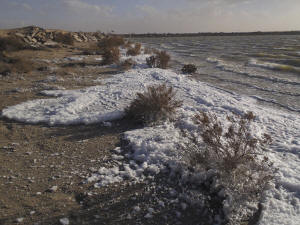Record levels of 'forever chemicals' found in wildlife near New Mexico
base, hunters warned
 Send a link to a friend
Send a link to a friend
 [January 30, 2025]
By SUSAN MONTOYA BRYAN [January 30, 2025]
By SUSAN MONTOYA BRYAN
ALBUQUERQUE, N.M. (AP) — Environmental regulators and health officials
in New Mexico are warning hunters that harmful chemicals known to cause
cancer in people have been found at record levels in birds, small
mammals and plants at a lake near Holloman Air Force Base.
In fact, state officials say the findings are some of the highest levels
documented in wildlife and plants worldwide based on comparisons with
other published studies. Researchers contracted by the state tested
muscle, liver and bone tissue in ducks, other birds and rodents as well
as eggshells, algae and even skin shed by a rattlesnake.
The findings come as more states in recent years have been forced to
issue health advisories to hunters and others as a result of “forever
chemicals” known as PFAS showing up in wild animals that are hunted for
sport and sustenance. From Maine to Michigan and beyond, wildlife
managers and scientists have been busy expanding testing as the scope of
the problem widens.
PFAS chemicals, or per- and polyfluoroalkyl substances, are an
increasing focus of public health and environmental agencies, in part
because they don’t degrade or do so slowly in the environment and can
remain in a person’s bloodstream for life.
In New Mexico, the concern centers on a lake that serves as the
wastewater reservoir for Holloman Air Force Base. It sits at the edge of
the base and near White Sands National Park. While hunting is now
prohibited there, state officials are concerned that the lake serves as
a layover for ducks and other migratory birds that could end up being
harvested elsewhere.

“The levels of PFAS contamination in Holloman Lake are deeply
concerning, particularly for hunters who may have consumed waterfowl
from the area over the past decade,” said Miranda Durham, the medical
director for the state Department of Health.
Durham and other state officials used the report made public Monday to
put more pressure on federal officials amid ongoing legal battles over
cleanup at Holloman and at Cannon Air Force Base in eastern New Mexico.
Contamination, mostly from firefighting foam used widely in training
exercises, has been detected at hundreds of military installations
across the United States. Experts have said cleanup will stretch into
the billions of dollars and will take years.
The New Mexico study points to the need for additional testing of
waterfowl and oryx samples to better characterize the risk to hunters
outside the immediate footprint of contamination at the base and the
lake.
Tasha Stoiber, a senior scientist at the Environmental Working Group,
called the levels of PFAS in wildlife at the lake alarming. But she said
they are not surprising given that the chemicals — used in nonstick pans
and many other products — are pervasive in the environment.
[to top of second column]
|

This March 13, 2019, image provided by the New Mexico Environment
Department shows foam along the shoreline of Holloman Lake near
Alamogordo, N.M. (James Kenney/New Mexico Environment Department via
AP)

“These chemicals accumulate in the body over time, creating serious
long-term health risks, including cancer, developmental harm and
immune system suppression,” Stoiber told The Associated Press. “The
situation at Holloman Lake highlights just how much more we need to
understand about PFAS contamination in wildlife and the broader
environment.”
In Maine, the state wildlife agency is working with university
researchers to track deer and turkey to understand how their
movements could potentially influence exposure. That state currently
has advisories for three areas, including one that spans 25 square
miles, where the risk is higher because of the historic use of
contaminated fertilizer for fields — a practice now banned there.
“We’ve issued some advisories, but it’s not widespread like a
landscape-level issue at all,” said Nate Webb, the wildlife director
for Maine's Department of Inland Fisheries and Wildlife. Still, Webb
said it feels like the more sampling that's done, the more places
that PFAS pops up.
New Mexico regulators say the work at Holloman Lake indicates the
reach that these chemicals have in the environment. They also point
out that New Mexico's ecosystems are tied to the state's cultural
and economic wellbeing.
Matthew Monjaras, who leads the nonprofit group Impact Outdoors, has
been hunting duck and other big game for more than two decades. He
is teaching his sons to do the same and is working with veterans and
school kids to expand access to the outdoors and improve wildlife
habitat through restoration projects.
While the potential for exposure through eating migratory waterfowl
is a concern even for hunters like himself who didn’t frequent the
lake, Monjaras said it is no more of an issue than eating
store-bought meat, catfish or even oryx. It is the reality of the
food chain, he said.
"We're a product of our environment,” he said.
___
Associated Press video journalist Brittany Peterson contributed to
this report.
All contents © copyright 2025 Associated Press. All rights reserved
 |